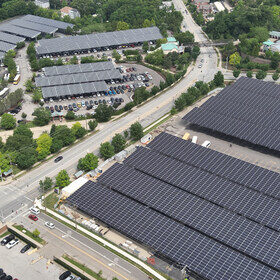Lightsource bp drops 300 MW solar project due to public opposition
Lightsource bp has abandoned plans for a 300 MW solar project in the US state of Ohio due to opposition from local residents.
EDF Renewables, Enbridge switch on 577 MW of solar in US
EDF Renewables and Enbridge have launched the 577 MW Fox Squirrel Solar project in Ohio. It provides renewable energy to Amazon as the US state’s largest operational solar farm.
Eaton releases commercial, industrial BESS
Eaton says its new xStorage commercial and industrial battery energy storage system (BESS) offers storage capacities ranging from 250 kWh to 1,000 kWh, using lithium iron phosphate batteries with self-contained liquid cooling.
The Hydrogen Stream: EU to move forward with H2 projects
The European Union will continue advancing hydrogen projects, focusing on infrastructure design and supporting production with European equipment, according to Ursula von der Leyen, president of the European Commission.
Cincinnati Zoo completes 2.8 MW solar carport
Terrasmart has designed and manufactured a racking system for a 2.8 MW solar carport project at Ohio’s Cincinnati Zoo and Botanical Gardens. The site’s owners claim it is the largest publicly accessible solar array in the United States, providing shade for up to 800 vehicles.
The Hydrogen Stream: US companies, institutions present hydrogen plans
As the hydrogen project in Appalachia moves on, American Airlines confirms its commitment to hydrogen aircrafts. Meanwhile, a Scottish distillery might soon run on hydrogen for whisky production.
US, Canada ramp up solar glass plans
With PV module capacity ramping up, glass suppliers have been investing in new solar glass production capacity. As in India and China, new facilities are popping up in North America, with unique twists to ensure competitiveness, such as using recycled material.
Weekend Read: The fruitful search for other thin films
First Solar and its cadmium telluride (CdTe) technology dominate thin-film solar in the mainstream market. Valerie Thompson looks at the US-based business and the future of thin-film PV technology.
Rear-side passivation for 17.4% efficient CdTe thin film
Scientists in the United States investigated adding a layer of copper-aluminum oxide to the rear side of a cadmium-telluride thin film cell, finding positive impacts on carrier lifetime and efficiency. With further work, the scientists say, the discovery could open up new routes to higher efficiencies in CdTe solar cells.
Bifacial perovskite solar cells may become more eco friendly than crystalline ones
A US study has suggested the raised energy yield of bifacial perovskite devices effectively means they could have a lower environmental impact than conventional crystalline cells. The researchers considered single-junction cells with high and low bandgaps and similar, multi-junction devices with two and four-terminal structures.









